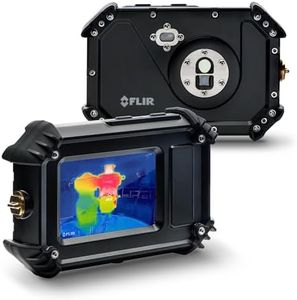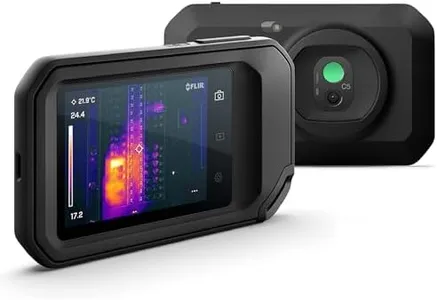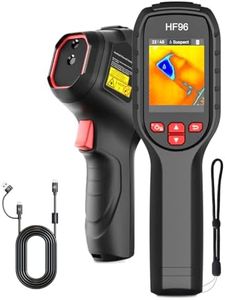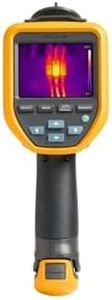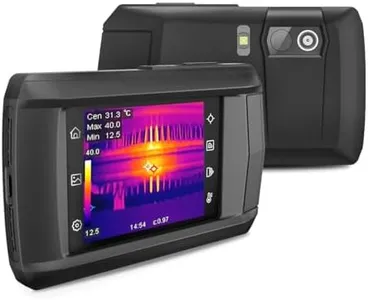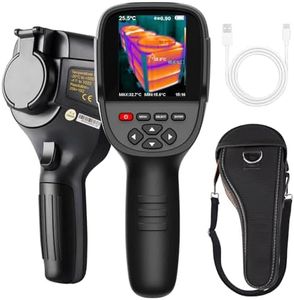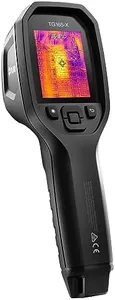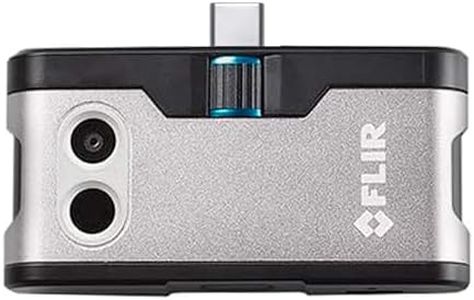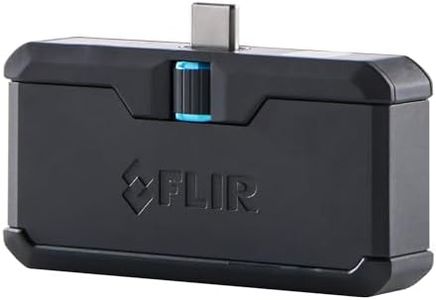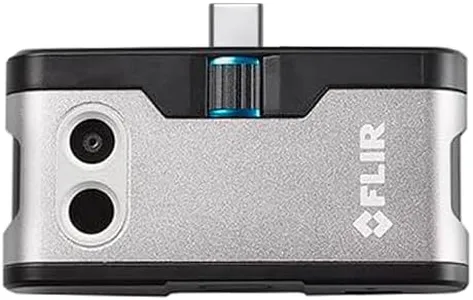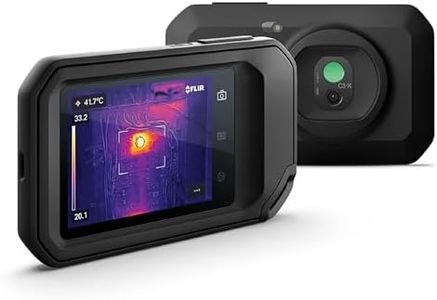10 Best Thermal Infrared Cameras 2025 in the United States
Our technology thoroughly searches through the online shopping world, reviewing hundreds of sites. We then process and analyze this information, updating in real-time to bring you the latest top-rated products. This way, you always get the best and most current options available.

Our Top Picks
Winner
FLIR Cx5 Hazardous Location Rated Thermal Imaging Camera with WiFi: High Resolution Infrared Imager
Most important from
1241 reviews
The FLIR Cx5 is a handheld thermal imaging camera designed for use in hazardous environments, making it a practical tool for professionals who need safe and reliable temperature measurements. It captures thermal images at a resolution of 160 x 120 pixels, which is decent for spotting hidden faults but not the highest in the market. Its temperature range from -20°C to 400°C (-4°F to 752°F) covers most common industrial and maintenance needs. The camera features FLIR's patented MSX technology, which adds visual details to thermal images, making them easier to interpret without losing thermal accuracy. This is especially useful if you're troubleshooting or diagnosing issues.
The device includes a 1080p video capture for visual context and supports picture-in-picture mode to compare thermal and real images side by side. In terms of usability, it offers WiFi connectivity for direct uploading to FLIR's cloud service, simplifying sharing and reporting. The battery lasts around 4 hours, which is sufficient for typical work sessions, and the camera is lightweight at about 6.7 ounces, making it comfortable to handle. Its compact size and included wrist strap enhance portability and safety during use.
The FLIR Cx5 benefits from a strong warranty program, including 2 years on parts and labor and 10 years on the detector, reflecting confidence in its durability. If you need a thermal camera for general industrial inspections or maintenance in hazardous locations, the Cx5 provides a solid mix of features, ease of use, and reliability. For those requiring higher resolution or very sensitive thermal detection for detailed analysis, more advanced options are available.
Most important from
1241 reviews
Fluke FLK-TIS60+ 30HZ, Thermal Imager; GT1; 30 HZ
The Fluke FLK-TIS60+ 30HZ thermal imager is a solid choice for professionals needing a reliable tool for thermal imaging. One of its main strengths is its ease of use; the touchscreen simplicity and point-and-shoot fixed focus minimize the need for extensive training. Additionally, the IR-Fusion technology allows users to adjust the level of infrared and visible light, which can be very helpful in various work environments.
The camera also supports efficient data management through Fluke Connect, enabling the capture and organization of multiple measurements by asset. Voice annotation and IR Photo Notes functionality add to the convenience, allowing users to capture accurate information easily. This device is a Class 2 laser product, making it safe for normal operation with an output power below 1 mill watt. It comes with 2 lithium-ion batteries, ensuring you have sufficient power for prolonged use.
However, there are some areas where it might not be the best fit. The thermal imager operates at a frame rate of 30 Hz, which might be limiting for users who need higher frame rates for more dynamic or fast-moving thermal events. The product dimensions (15.5 x 11 x 8.58 inches) and weight (1 pound) make it relatively bulky, which could be an issue for users who require a more compact and lightweight device for fieldwork. Lastly, while the product offers good resolution, temperature range, and sensitivity, potential buyers should ensure these specs meet their specific needs before purchasing.
FLIR C5 Compact Thermal Imaging Camera with Wifi: High Resolution Infrared Imager for Inspection, Electrical/Mechanical, Building, and HVAC Applications
Most important from
1241 reviews
The FLIR C5 Compact Thermal Imaging Camera is a versatile tool designed for inspection, electrical and mechanical work, building, and HVAC applications. It offers a good temperature range from -20 to 400°C (-4 to 752°F) and features 160 x 120 true thermal imaging with MSX technology that enhances the clarity of images by embossing visual details. This makes it easier to identify and troubleshoot hidden faults, potentially reducing diagnostic time.
The camera's NETD (sensitivity) and field of view (FOV) are adequate for most professional uses, ensuring it captures clear and accurate thermal images. Additionally, the camera supports cloud connectivity via FLIR Ignite, which simplifies the process of documenting and sharing thermal images and creating professional reports. This feature can be particularly useful for technicians who need to share findings with customers or colleagues quickly.
The camera is also durable, being waterproof, and comes with a robust warranty (2 years for parts and labor, 10 years for the detector). Its ergonomic design and lightweight build (6.7 ounces) make it easy to handle and carry around for field use. However, the resolution (160 x 120, 19,200 pixels) may not be the highest available in the market, which could be a limitation for applications requiring extremely detailed thermal imaging. While the FLIR C5 includes convenient WiFi and SD card storage, it relies on AAA batteries, which might not be as convenient as rechargeable options. This camera is best suited for professionals in maintenance, repair, and inspection fields who need a reliable and easy-to-use thermal imaging solution.
Most important from
1241 reviews
Buying Guide for the Best Thermal Infrared Cameras
Choosing the right thermal infrared camera can be a bit overwhelming, but understanding the key specifications can help you make an informed decision. Thermal infrared cameras are used to detect heat patterns and temperature differences, which can be useful in various applications such as building inspections, electrical inspections, and even medical diagnostics. To find the best fit for your needs, consider the following key specifications and how they align with your intended use.FAQ
Most Popular Categories Right Now


